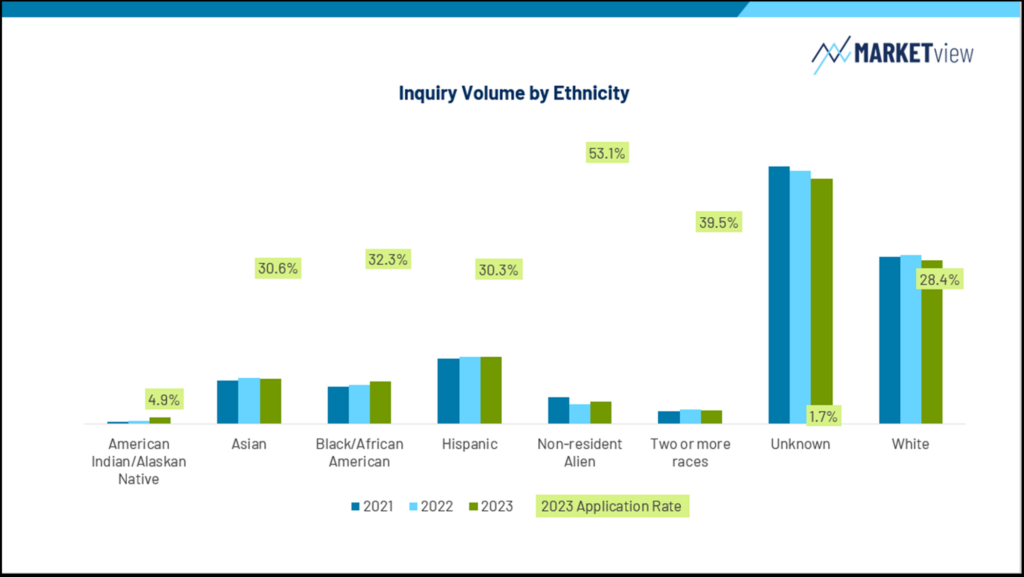Colleges continue to face major, new challenges that fundamentally disrupt the way they have long operated. The impact of the recent Supreme Court ruling on affirmative action changes the ground rules of enrollment and may lead to other ground rules kinds of changes—relative to the admission of legacy, faculty, or policymakers’ children, for example—though none of these entail civil rights. How colleges adapt their recruitment and admission practices will be unique and evolutionary—we won’t know what form these adaptations will take until we see them. Whatever path a college or university might choose, it will do so in the midst of a late rollout of a changed FAFSA and a new Student Aid Index (SAI) algorithm, a major shift in Student Search, and a market that is experiencing a rapid test-optional-driven, post-Covid restructuring.
Live Q&A: How Will the Supreme Court’s Ruling on Affirmative Action Impact My Institution?
Impact of the Supreme Court Decisions
In late June, the Supreme Court released its decisions in the Students for Fair Admissions Inc. v. President & Fellows of Harvard College, and Students for Fair Admissions v. University of North Carolina cases, effectively rendering the practice of affirmative action as we know it, unconstitutional. These decisions will force some schools to challenge long-held assumptions and change long-standing practices that have guided admissions decisions for years. However, this will not affect every school equally, nor even most schools’ admissions decisions significantly, but there will undoubtedly be ripple effects across the market.
For schools where this will have the greatest impact, they must depart from the traditional practice of using affirmative action as part of their admissions decisions. This also means that financial aid policy must also evolve, as schools can no longer preference one race over another as an aid factor in determining their financial aid policy. While rethinking approaches to admission and financial aid, many schools are working with their legal teams to interpret and navigate the extent of the Supreme Court decision on their practices and should continue to do so as the full impact of these decisions is understood in a practical sense.
It shouldn’t go without saying, so we’ll say it: you should read the decision and also the analyses economists prepared for each side in support of their respective arguments before the Court. The Court did not overrule its precedent in the prior Michigan case, which looked favorably on the educational value of diversity and the utility of holistic admission—assessing the contribution and qualification of each applicant. But here they found the parties fell far short of a provable “strict standard” that criteria for admission do not systematically favor one race over another. And, that earlier decision had directed that such holistically applied affirmative action be temporary, that there be a plan to arrive in the future at a diverse enrollment reality for which any consideration of race would be unnecessary.
As to the analyses, beyond how informative these exercises in applied social science are, they also illustrate the depth at which both the trial courts and the Supreme Court engaged with the admissions policies and practices at Harvard and North Carolina—beyond the testimony.
This leads to a couple of very obvious observations: as colleges adjust, their legal counsel will try to guide them clear of rocks and shallow water. The second is that there are litigants in the wings. The third is the crucial role data and analysis—and the integrity of each—will play in identifying opportunities to engage, attract, and serve all students, better, and in supporting the path you take.
Despite the new restrictions on admissions decisions and financial aid policy, schools can still engage in targeted marketing and outreach to any demographic and should work to build relationships with students “who should be in your pool but are not.” For those schools that are the most selective and therefore the most affected and seek to maintain consistency for future classes, there’s now a greater premium on recruitment strategies.
All of these changes put even more pressure on enrollment leaders—they will have an elevated role and a greater responsibility to help their colleagues across campus understand the new market realities and what actions and investments will be the most strategic to support their institutional goals.
The Importance of Mission and Strategic Goals
In these moments of uncertainty and disruption, schools must hone and then stick to their missions and clearly define their strategic goals and how these goals support their missions. Knowing more about your funnel and shaping it towards your goals accordingly has never been more important. Identifying your target students and communicating with them early is a must. You can’t enroll students who are unaware or unengaged.
Leveraging MARKETview to Meet Emerging Challenges
With MARKETview at the center of their decision-making, we can help our partners navigate this evolving landscape together. MARKETview can provide schools with the data they need to support their goals and optimize the new admissions and financial aid policies they develop. Leveraging data and context from colleges across the market enables institutions to make informed decisions based on market realities.

One of the primary benefits of MARKETview is the ability to gain early insights into the students that institutions want to recruit. While making admissions decisions on the basis of race must end, schools are not prohibited from building inquiry pools of any demographic. MARKETview provides an aggregated data set that can help schools build a more diverse pool by filtering inquiries by IPEDS race and ethnicity categories, target household income and more. If a partner school has a goal to increase diversity, MARKETview helps them understand how their inquiry pool is building, what the class composition looks like and if they are on track to meet their target.
Moments of disruption like these are why MARKETview exists. We can provide real-time data and insights, enabling institutions to make informed decisions earlier than ever before possible, so schools can achieve their goals in the face of uncertainty.
Interested in learning more? Schedule a demo with us.
